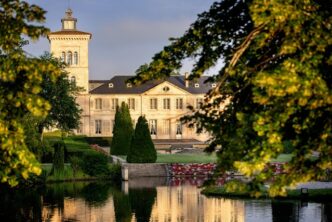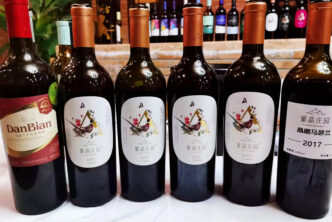This is the first in a three part series of vertical tasting reports devoted to Alsace’s outstanding Dirler-Cadé estate. These three absolutely one of-a-kind tastings going back to thirty years of wine have not been chosen haphazardly: in a style exercise that is what I envision for the TerroirSense Wine Review and its raison d’être, its very path of the present but even more its future course too, this is the continuous in-depth analysis and storytelling of wine in ways not done normally. To wit, these three verticals are aimed at analyzing and studying the terroir of specific Alsace grand crus and the different expression of grape varieties in the same grand cru. Not your usual wine magazine fare, perhaps, but highly interesting and a unique learning opportunity. By that I mean not just to learn about wine: but in the process of reading and hopefully thinking, to discover a wine estate’s work and passion, to appreciate and like a grape variety and wine you may not be so acquainted with, and to fall in love with a wine region which just happens to be one of the world’s most beautiful.
Here you have the first report in the series: an analysis of the expression of Muscat grapes in the Alsace Grand Cru Saering. But how does the same Muscat grape variety/varieties get translated by another terroir, another Grand Cru? Therefore next up is another vertical, but this time of the Muscat variety/varieties seen through the lens of the Spiegel Grand cru, by way of the Dirler-Cadê Alsace Muscat Spiegel Grand Cru wine. Last but not least, how does the same grand cru transalte a different grape variety? Is the grape variety dominated by soil, topography, microclimate? Or does the grape win out? Or does it live in an ideal symbiosis with the other factors of terroir? And so, the third and final vertical in this series of tasting reports will feature the Dirler-Cadé Alsace Riesling Saering Grand Cru wine. Riesling vs the Muscats, amongst the world’s oldest and most popular wine grape varieties duking it out, no holds barred, take no prisoners, just go all out. All-right then, may the fireworks begin.

The Saering is an Alsatian grand cru located roughly twenty-six kilometers south of Colmar (a road I have travelled countless, and I mean countless, times over the last thirty years) in the north-eastern reaches of the territory of Guebwiller (the town the Saering is associated with). The Saering is a famous Alsatian grand cru that has a mostly south-east to east exposure, situated between 260-300 meters above sea level. It is 27.45 hectares large, of which roughly twenty hectares belong to the Schlumberger estate, Alsace’s largest privately-owned wine estate. However, there are other noteworthy estates making wines from this hallowed site, such as Dirler-Cadé. For those who love wines of terroir, the Saering Grand Cru makes some of Alsace’s most classically dry, jaggedly mineral wines the profile of which makes them fairly easy to recognize in most (well-organized) blind tastings.
Specifically, the Dirler-Cadé family has a way with Alsace’s Muscat varieties (and Sylvaner too). Frankly, it’s not such common a gift to have; and it’s also not so common to find so many great Muscat wines, and that age exceptionally well on top of it, at just one address. Make no mistake about it: I like Dirler-Cadé’s Riesling, gewurztraminer and Pinot gris wines, even their sparklers: but what they achieve with the Muscat varieties (and Sylvaner) is really uncommon. Good for them, and good for all us informed wine lovers.
A little bit of history
The origin and the meaning of the Grand Cru’s name, Saering, are not completely clear, though there are a number of explanations that have been brought forward over the years; rather acceptable in their logic, all are likely candidates. The word saering can literally translate to the “sea ring”, most likely in honour of the oceans that used to cover the Rhine valley floor eons ago and the cru’s shape, which is somewhat reminiscent of a ring-like structure. Another, possibly more likely interpretation, is that seering derives from the Germanic “seering”, a reference to the iron rings that were used to tie ships with at port (and one such ring was found in the vineyard, embedded in one its rocks). However, an erudite 1866 interpretation, according to the Abbot Braun who was a chronicler of old Alsatian fables and tales (tall or not) is that the word saering also refers to an ancient Roman camp (and therefore derived from “sehring”), given by uniting the word seh (from Sehen) and ring, meaning a military observation or guard camp that was once located on the premises (apparently, Braun believed this site to be magical and the home of Odin, one of the most powerful if not most important gods of Norse mythology, associated with wisdom, death, knowledge, war, and the guardian ruler of the “hall of the slain”, better known as Valhalla) .
While doubts remain over the exact meaning and derivation of the cru’s name, there is no doubt that the Saering, like some other – but certainly not all- Alsace grand crus including Eguisheim’s Eichberg, Riquewihr’s Shoenenbourg and Thann’s Rangen, has been famous for a very long time. This at least since the fourteenth century (though the word saering first appears in the literature in 1250, in relation to the Abbey of Murbach); its wines were much sought after by neighbouring wine lovers, and were routinely sold to cities in modern day Switzerland and Austria. Documents show that by the eighteenth century, people in the towns of Guebwiller and nearby Bergholz were using the Saering’s name (then a lieu-dit, as Alsace’s grand cru classification was not yet in place) to identify wines from that specific, immediate, area.
The Saering’s terroir
The Saering finds itself esconced into what I have termed before is Guebwiller’s “grand cru alley”, a relatively small stretch of land blessed with four grand cru sites, lying more or less next to each other. The Saering is located immediately to the east of the Kitterlé (from which it is separated by a geological fault line) and south of the Kessler Grand Crus; the Spiegel Grand Cru is also northwards of it, if a little more removed. Though close to the other three grand crus, the four could not be more different, and not just from the perspective of the wines that can be made from each. The Saering can be generically summed up as being a sandstone-limestone site of Lattorfian age, with a mostly limestone subsoil (that will surface from spot to spot) and a rather heavy soil rich in Bundsandstein age stones and rocks with layered pockets of marly-clay. Or to put it somewhat more simply, it’s essentially a marly-sandy site where sandstone and granite rocks have deposited in time over a limestone spur.
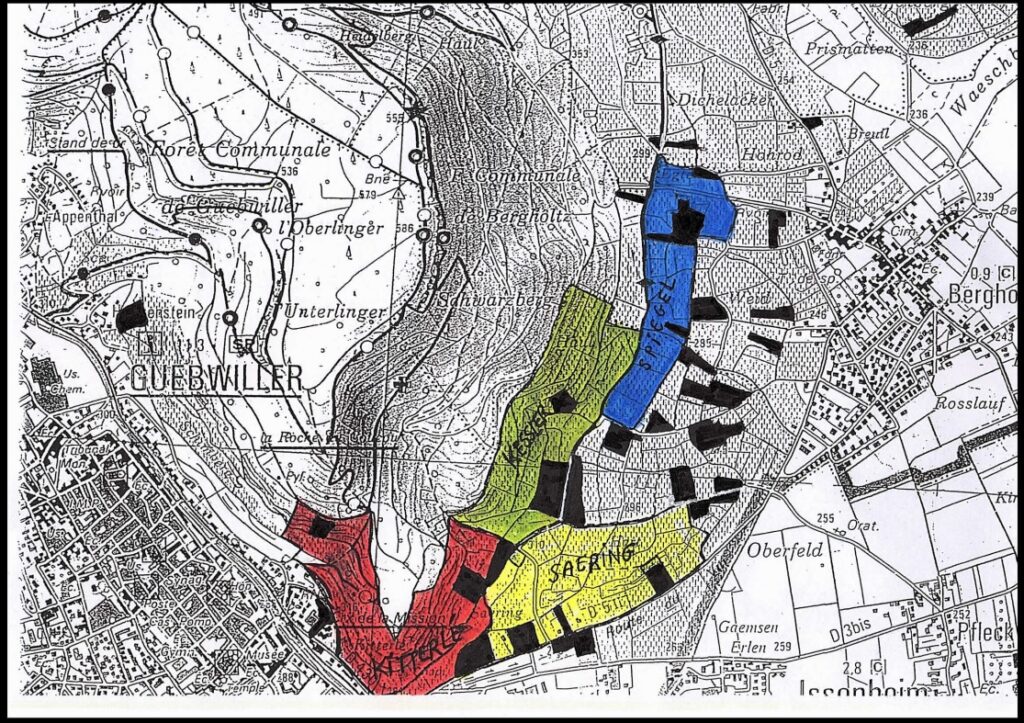
It’s also a steep site (though less so than the neighbouring Kitterlé), and the Saering’s wealth of rocks is further documented by its being dotted with stone walls, patiently built and rebuilt over the last three centuries or so. It is also a relatively warm site, well protected from the cold northern winds by the Vosges mountains, such that grapes ripen relatively early in the growing season. All of which tells you that it is an ideal site in which to plant Riesling (in fact, 6.4 hectares or 84% of the grand cru is planted to this wine grape), the Muscats (roughly 6% of the total grape plantings; and yes, Muscats, plural, because you know that Alsace grows not one but two distinct Muscat varieties, not to mention a biotype or two of at least one of those varieties as well), Gewurztraminer (again, about 6% of the total) and Pinot Gris (4%). Allow me to venture that, given the quality of some of the Pinot Gris wines I have tasted from this site over the decades, a little more could stand to be planted within its boundaries. Just sayin’.
A general overview of the wines of the Saering
According to Jean Dirler, the presence of deep clay formations and porous soil helps the Saering make beautiful wines in dry years such as 2016 that might otherwise be marked by wines characterized by the effects of drought. Clearly, any wine made with Muscat varieties will always be heavily aromatic, and it is no different with the Alsace Muscat wine of the Saering, though there is no doubt that the typical profile of these grapes is somewhat muted and modified by the Saering’s terroir. Lime, orange blossom, aromatic herbs, mint are all descriptors that are all ideally suited to describing the aromatic molecules discernible in the Muscat wines of the Saering: but their expression is quite a bit different in the Saering Muscat wines comapred to that of Muscat wines born off other Alsace Grand Crus. For instance, a very intense mineral presence is never absent in any of the Saering’s wines (never mind Muscat varieties, or Riesling of course: this trait is very apparent when you drink a Pinot Gris from the site, some of the most jaggedly rocky and saline Pinot Gris/Pinot Grigio wines you will ever taste) and the refreshing touch of salt (again, a halogen effect) lingers long, and markedly so, on the finish.
Again in my experience, the Saering is the Grand Cru that tends to give some of the most classically dry wines of all of Alsace’s Grand Crus (or to be more precise, it is a Grand Cru the wines of which need to be classically dry in order to be balanced and memorable). Put in another way, the best Saering wines achieve greatness status when they deploy that combination of classically dry salinity and fruity intensity that is instantly recognizable even when tasting blind. This is true whether we are discussing a Saering Muscat, Riesling or even Pinot Gris wine. It’s a combination that you may or may not like as it translates to the wine, but it is certainly rather unique to this Grand Cru
Dirler-Cadé and the Saering
The Dirler-Cadé estate was born out of marriage (just like it was for the well-known Alsatian estate of Zind Humbrecht) when the two families joined in wedlock. Both families have very ancient ties to winemaking: Dirler back to 1871 and Hell-Cadé back to 1898, though the latter family was active in the wine and food industry already as of 1887 (for the full story on this family and winery, please see next Friday’s, June 3, Vertical Tasting report on the Dirler-Cadé Muscat Spiegel Grand Cru). Today, the winery is run by the fifth generation of Dirlers and Cadés: the husband and wife team of Jean Dirler and Ludivine Cadé, with his parents also involved. They own vineyards in grand crus (about 50% of the winery’s holdings) as well as in five different lieux-dits. The estate is fully organic and biodynamic certified (Agricolture Biologique or AB and Biodyvin, respectively).
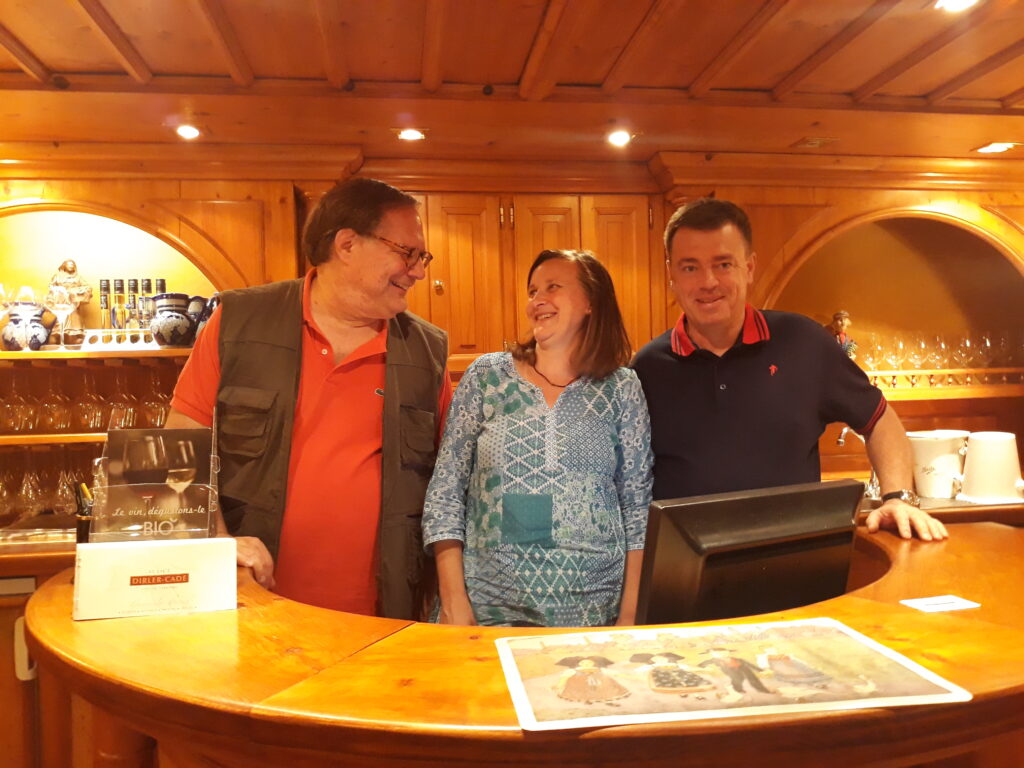
The estate first bought vineyard land in the Saering back in 1975 when they got a hold of 75 ahres (twenty-two of which they replanted); over time, they bought more. Today they own 2.5 hectares of which 1.10 hectares are planted to Riesling and the rest is planted to the Muscat grapes (0.88 hectares) and to Gewurztraminer. Both Muscat varieties are grown in the Saering by the Dirler-Cadé’s (see below). The soils are marno-calcareous with sandstone (the eastern portion has more sandstone, while the western is more calcareous).
Dirler-Cadé and the Muscat varieties
When one thinks of Alsace, the first thing that comes to mind are either Riesling or Gewurztraminer; and so it should be given that the latter grapes give the greatest wines from this variety in the entire world, and the former represent probably the best expression of classically dry Riesling wines made anywhere in the world too. But what people often forget, or are just not aware of, is how amazing are (can be) Alsace’s better Sylvaner and Muscat wines. (I have already written up in the past a vertical of Dirler-Cadé’s wonderful Sylvaner wine when I was an editor at Stephen Tanzer’s International Wine Cellar; more recently, a vertical in the TerroirSense Wine Review of Burn/Clos St.Imer’s Sylvaner (see TerroirSense Wine Review: Verticals, ), and another vertical report, this time of Muré’s outstanding Sylvaner Cuvée Oscar is coming up next month too.)
Relative to Alsace and Muscat, you need to know two important things: the first is that Alsace grows three different Muscats; and the second is that Dirler-Cadé is one of the region’s three best producers of Muscat wines. In fact, the Alsace Muscat varieties are two; a third is actually a biotype of one of the two aforementioned varieties. The two distinct Alsace Muscat grape varieties are Muscat Ottonnel and Muscat d’Alsace, both white-berried Muscat grapes. The third Muscat grape, much less common in Alsace but not exactly rare either, is the red-berried biotype of Muscat d’Alsace. Muscat d’Alsace is also called Muscat à Petits Grains and is better known the wolrld over as Moscato Bianco or Muscat Canelli (that’s right: it is none other than the world-famous white muscat grape used to make the Moscato d’Asti wine). It gives the more structured Alsatian Muscat wine, though it doens’t always ripen fully in Alsace’s cooler northern weather [though that is not quite so true anymore to the same extent that it once was thanks (???) to climate change]. Vineyard management of Muscat d’Alsace is even less of a picnic because it’s tough to tie to the trellissing wires as the shoot arc tends to break easily. By contrast, Muscat Ottonnel gives very little body to the wine but rather an amazingly intense floral perfume, so it blends very well with the other; unfortunately Muscat Ottonnel is prone to berry shatter and hence greatly reduced yields, a characteristic which doesn’t exactly endear it to most farmers, who tend to be of the practical sort.
Dirler-Cadé first vintage of Muscat Saering is the 1985, but have not made it every year (dependent on the vintage weather). As mentioned, they own 0.88 hectares of Muscat vines in the Saering, of which 0.63 hectares are of Muscat Ottonel and 0.25 hectares of Muscat d’Alsace (which is different from their Muscat plantings in the Spiegel Grand Cru where there is even more Muscat Ottonel; however as I shall explain shortly, when they need to replant, they choose preferably Muscat d’Alsace nowadays). Dirler-Cadé’s Muscat vines are planted in three separate plots of varying vine age (one plot is forty-nine years old; the grapevines in a second plot are twenty-two years old; and those of the third plot range from eight to sixteen years of age). Unfortunately, the volume of this delightful wine that is made each year is limited. For example, there were only 2514 bottles of the Mucat Saering Grand Cru made in 2019; and at 1637 bottles, they were even fewer in 2020. Much of that depends on weather-related flowering and other issues. However the good news is that when conditions permit, Dirler-Cadé will also make a classic, generic Muscat wine from a selection of grapes from the two grand crus and blend them together (usually a 67% Saering and 33% Spiegel mix). I wish to make clear that it is an unbelievably good Muscat wine, so Muscat-lovers out there would do well to look for it. Though it does not bear a grand cru name on the label, trust me, the thing is as good as many Muscat wines you’ll drink from anywhere in the world.
As mentioned, these same two Muscat varieties are also present in Dirler-Cadé’s holdings in the Spiegel Grand Cru (as mentioned previously the subject of my Vertical Tasting report here on TerroirSense Wine Review this coming Friday, June 3). Given that the Dirler family grows the grapes and makes the wines in exactly the same way, comparing the winery’s Spiegel and Saering Muscat wines (from the same vintage, clearly) allows all wine lovers to catch a rare glimpse of how the same grape variety/ies, can give totally different wines based for the most part on finite geologic, climate and topographical differences only.
In the Saering, Dirler-Cadé’s Muscat grape vines are planted with a south-eastern exposure on pink and grey-brown sandstone covered by Oligocene-origin limestone (calcaire d’Oligocène). This is a very different scenario from that of Dirler-Cadé’s Muscat vines planted in the Spiegel Grand Cru, which are fully south-facing and the soil is richer in clay than the Saering. Typically, the Saering gives a highly citrussy Muscat wine that boasts plenty of savoryness and energy, but with a slight tannic characteristic. Even Jean Dirler doesn’t really know why there is that tannic nuance, he just knows it’s always there. For sure, Saering Muscat wines are on the average both more vibrant and austere, with a more masculine personality than many other Alsatian Muscat wines that are daintier and quite floral.
The Saering Muscat wines are slightly fuller-bodied than those of most other Alsace Muscat wines (a sensation to which their underlying tannic spine no doubt contributes to), and so can stand up to richer dishes and foods with bigger textures. Though I wouldn’t hesitate to pair the Saering Muscat wine with oysters and shellfish just like any other Muscat wine, its size is such that it also goes very well with goat and sheep cheeses with aromatic herbs; fennel salad with lemon and olive oil dressing; orange salad with fennel and herbs; and even salmon steaks with complex sauces such as Hollandaise, or dill. For something non-French, the classic Italian caprese salad (tomato, mozzarella and basil: the basil is key, it has to have plenty of oungent perfume, or this pairing won’t work); toasted bread with green olives, fresh goat cheese and sun-dried tomatoes, spaghetti with clams, and even a seafood pizza with a non-tomato base and no cheese. A very Alsatian tarte flambée with cumin, coriander, mint, lemon pepper and calamari will also work very well.
(As usual, this trip was paid for out of pocket by Ian, including air flight, transport and accomodation. No funds, sponsorships or paid travel of any kinds were or are accepted by him or by the TerroirSense Wine Review: Ian writes about the estates and the wines he wants to write about and whom he believes can provide educational opportunities by which he and every other wine lover may grow).
The wines in this vertical tasting
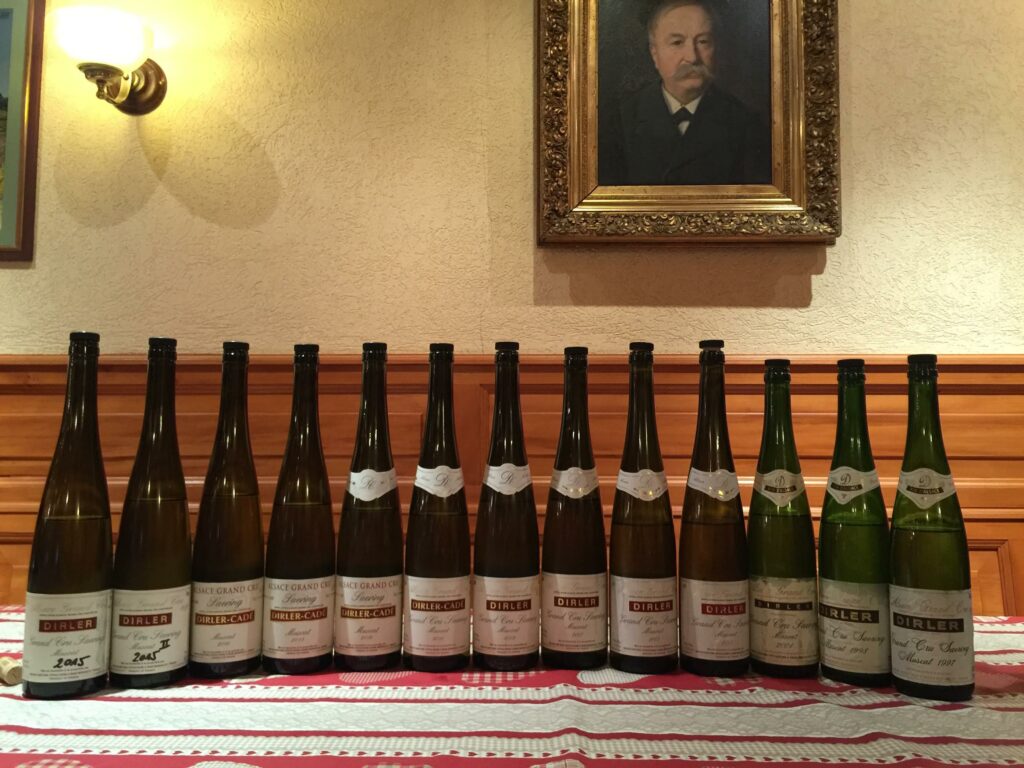
Dirler-Cadé 2018 Muscat Saering Grand Cru Alsace 94
Bright straw-green. Fresh pink grapefruit, fennel, and grape juice aromas and flavours are lifted by hints of mint and white flowers. Offers a deep, multilayered and textured quality that is enticing. Finishes long, with vibrant texture and clarity. A blend of 55% Muscat Ottonel and 45% Muscat d’Alsace, this boasts 5.21 g/L r.s and 6.29 g/L total acidity. Drinking window: now-2030.
Dirler-Cadé 2017 Muscat Saering Grand Cru Alsace 92
Luminous, deep straw-green. Aromas lime, licorice and quince are enlivened by hints of jasmine and yellow acacia flowers. Juicy, spicy and perfumed, with pure flavors of citrus peel, anise and minerals lifted by good inner-mouth perfume and nicely extended by racy acidity on the long juicy aftertaste. This tastes very dry (only 0.5 g/L residual sugar apparently). Drinking window: now-2028.
Dirler-Cadé 2016 Muscat Saering Grand Cru Alsace 91
Bright medium-dark straw with green tinges. A panoply of fresh citrus fruits on the nose: tangerine, lime, grapefruit, and orange oil. Broad and round in the mouth, with simialr flavours to the aromas, but with bright limestone-derived citrussy acidity but good acid-fruit balance (0.4 g/l r.s., and 3.9 g/l total acidity) that really leaves a bright mouthwatering impression on the close. Though not the most intense Muscat Saering you’ll ever taste from this estate, it still offers good concentration for the year, plus plenty of flavour and only 13% alcohol.. I want to point out that the regular Muscat wine form the winery was really excellent too in 2016: so despite the difficulties posed by the vintage, at Dirler-Cadé the Muscats fared very well. Drinking window: now-2027.
Dirler-Cadé 2015 Muscat Saering Grand Cru Alsace 90
Green-tinged color. Lemon rather than lime on the nose, complemented by bright notes of mandarin and grapefruit. Then fresh in the mouth too, where its bright saline minerality is apparent with nuances of powdered stone and grapefruit that are pure but just a little short. This was harvested much earlier than the Muscat of the Spiegel (on September 10 instead of September 20). Drinking window: now-2026.
Dirler-Cadé 2015 Saering Cuvée Mathilde Muscat Saering Grand Cru Alsace 95
Dark, vivid straw yellow. Rich and ripe aromas and flavours of candied citrus and sweet spices. Long and ripe but with plenty of freshness. This is quite sweet, practically a Vendanges Tardives level (but not quite). Boasts 32 g/L residual sugar but plenty of freshness to keep dancing on your palate in a non-cloying manner. Jean in fact wanted to make a Vendanges Tardives (VT) wine, but as he felt the grapes on the vine were slowly but surely losing freshness he pulled the trigger on September 30, but short of the target must-sugar level required for the wine to be labeled as a VT. Try this as an apertif, or with fresh goat and blue cheeses, fruit salads, fennel and bell pepper salads, roast salmon with tropical fruit chutneys, and many Thai dishes of a sweeter ilk. Drinking window: now-2040.
Dirler-Cadé 2014 Muscat Saering Grand Cru Alsace 85
Full yellow colour. Strangely muted nose for a cool year and almost all Muscat Ottonel but this fails to deliver the variety’s typically explosive floral perfume. Then vibrant and fresh but alittle short. Like orangeade. Finishes saline. Only 10% Muscat d’Alsace and none of the the red berried biotype (variety?) as Drosophila (fruit fly) ate all of it. A very difficiult year for Alsace. Drinking window: now.
Dirler-Cadé 2013 Muscat Saering Grand Cru Alsace 95
Good full straw-green. A strong note of menthol on the nose says “Muscat d’Alsace” right away; but also very perfumed, with building reminders of passion fruit, orange peel, vanilla, lime and a sweeter spearmint (sweeter compared to the drier menthol note). Then very clean and very serious on entry and in the middle, with a floral nuance to a tapering quality brought on by noteworthy lip-smacking salinity. Closes long and vibrant, with a building, repeating note of menthol and of fresh spearmint. I could see Jean Dirler looking at me kind of funny when I kept insisting just how dominant the note of sweeter mint and drier menthol were in this wine right from the get-go; and when I finally asked him why he was looking at me so quizzically, he told me that there had been a patch of mint planted near the vines. Well, call me crazy, but it sure seemed like the mint oils made it over into the grapes! The 2013 vintage turned out to be a great one for the Muscat Ottonel and so this wine has only 10% Muscat d’Alsace. In general, Muscat Ottonnel-loaded wines are all about perfume and don’t age quite so well compared to those top-heavy with Muscat d’Alsace, but I think this beauty has the stuffing to last. Drinking window: now-2033.
Dirler-Cadé 2012 Muscat Saering Grand Cru Alsace 93
Luminous straw-yellow with green highlights. Very peppery with a hint of licorice on the nose and in the mouth, plus a strong dose of minerality. Very clean, long and tactile, this gorgeous Alsace Muscat wine is really very well-balanced. The aftertaste is long and bright, and has a delicate hint of peppermint and quince. A blend of 70% Muscat Ottonel and 30% Muscat d’Alsace. Drinking window: now-2030.
Dirler-Cadé 2010 Muscat Saering Grand Cru Alsace 91
Bright straw. Bruised apple and herbs complicate ripe citrus aromas on the nose. Then rich and suave, with a sweet glyceral nuance to the herb and peach tea flavours. Finishes tactile and rich. More evolved than the other wines in this series; Dirler admits he was fiddling around with lower sulfur doses at the time, and that may have something to do with this wine’s precocious evolution. It’s a bit of a shame really, because there’s a lot of beautiful fruit underneath. Don’t get me wrong: it’s still a beautiful wine that I’d enjoy drinking any day of the week, but I think this could have been a stellar wine. Drinking window: now-2025.
Dirler-Cadé 2009 Muscat Saering Grand Cru Alsace 95
Deep golden-tinged yellow. Intense notes of orange jam, peach nectar, crystallized grapefruit and guava on the explosive nose. Then rich, ripe and sweetly spicy, with an enticing mouthcoating lush quality tomits honeyed tropcial fruit flavours. Extremely long and multilayered. The hot 2009 vintage is evident here, but the Saering has helped deliver a wine that though ripe is very light on its feet and still fairly vertical. Well done. Drinking window: now-2033.
Dirler-Cadé 2007 Muscat Saering Grand Cru Alsace 87
Orange-tinged color. Bruised apple, peach tea and earthy tones on the nose and in the mouth. There was obviously less sulfur used here and the wine hasn’t aged especially well. Drinking window: now.
Dirler-Cadé 2005 Muscat Saering Grand Cru Alsace 96
Pale golden-yellow. Lovely aromas of marmelady botrytis, lemon curd, lime cordial, gin and minerals. Rich, ripe and juicy, with lively but very harmonious acidity nicely extending the flavours on the long, rich and tactile back end. Very well balanced and aging spendidly, you’d never guess this is now seventeen years old. Mainly Muscat Ottonnel, with about 15% Muscat d’Alsace. Jean reminded me that it had rained a little just before the harvest (I had honestly forgotten all about it), which is a bit of a shame because of the dilutional effect it engendered. Nevertheless, the 2005 vintage is one I especially love for the Muscat Saering because the grapes were partially hit by noble rot (3-4%), and you can tell. Much greater complexity, lusciousness and depth here than is common. Drinking window: now-2030.
Dirler-Cadé 2004 Muscat Saering Grand Cru Alsace NR
Slightly tired yellow gold colour. A little truffe at first, but veers towards the frankly vegetal on the nose. Then fresher and cleaner in the mouth, though there’s a hint of a green streak to the flavours of maracuja and other tropical fruit. Here the Saering Muscst’s typical tannic note really does come to the fore on the back end. This is just a little too green for my taste. Drinking window: now.
Dirler-Cadé 2001 Muscat Saering Grand Cru Alsace 94
Bright straw-yellow gold. Nice depth to the rich orange jam, lemon curd and cool minty aromas and flavours. Rather similar to the brilliant 2005 Muscat Saering made here, but with more volume and less complexity than that wine. The nose hints at an incipient evolution, but overall this lovely Muscat is aging well. The aftertaste showcases a citrussy bitterness that will leave your mouth feeling clean and fresh. I might have left a little more residual sugar for better balance, but make no mistake about it, this is a knockout Muscat wine. Drinking window: now-2028.
Dirler-Cadé 1998 Muscat Saering Grand Cru Alsace 94
Good full lively yellow-gold. Minty nuances complicate the orange and lemon aromas and flavors, and a sweeter note of lime cordial and tangerine note adds volume. Very clean and ripe, but with noteworthy balance to the rich flavours that are long and very precise. This is still very young. Drinking window: now-2032.
Dirler-Cadé 1997 Muscat Saering Grand Cru Alsace 91
Medium dark straw yellow. Evolved nose of forest floor, truffle and citrus peel. There’s lovely length and a tactile, slightly tannic mouthfeel that are typical of the Saering Muscat, but this is still lovely. You can tell it must have been a really spectacular wine about ten years ago. There are no older Saering Muscat wines at Drielr-Cadé the winery because prior to this date they used to blend the grapes from this grand cru in with the others to make more of the entry-level, classic Alsace Muscat wine. Drinking window: now.
See also: Another 30 Years and Counting: Dirler-Cade Muscat Spiegel Vertical 1987-2017
And Dirler-Cade Riesling Grand Cru Saering vertical 1990-2015

 English
English
